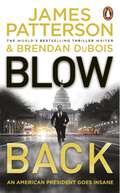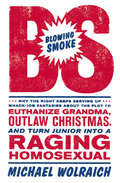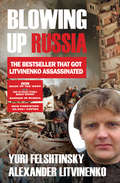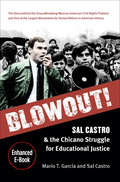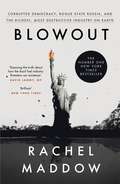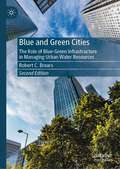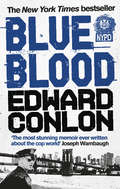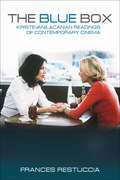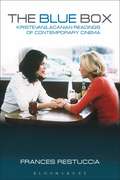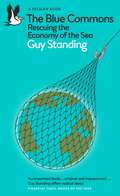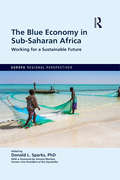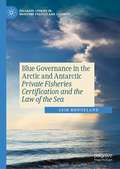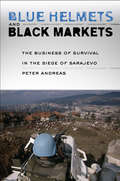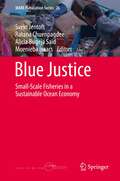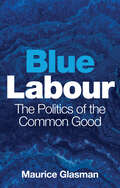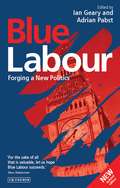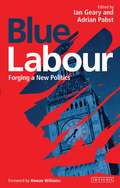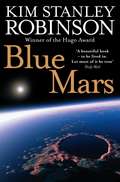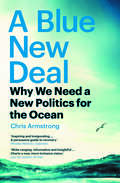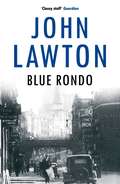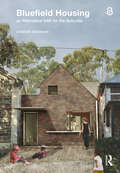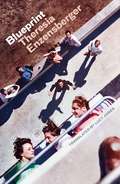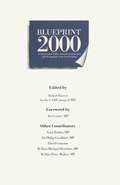- Table View
- List View
Blowback
by James PattersonHe's America's most brilliant president ever. He's also a psychopath. US president Keegan Barrett swept into office on his success as director of the CIA. Six months into his first term, he devises a clandestine power grab with a deadly motive: Revenge. President Barrett personally orders Special Agents Liam Grey and Noa Himel to execute his plan, but their loyalties are divided. As CIA agents they've sworn to support and defend the Constitution of the United States against all threats, both foreign and domestic.When the threat comes directly from the Oval Office, that's where the blowback begins._______________________________________Praise for James Patterson'The master storyteller of our times' Hillary Rodham Clinton 'No one gets this big without amazing natural storytelling talent - which is what Jim has, in spades' Lee Child 'Nobody does it better' Jeffrey Deaver 'A writer with an unusual skill at thriller plotting' Mark Lawson, Guardian'One of the greatest storytellers of all time' Patricia Cornwell 'James Patterson is The Boss. End of.' Ian Rankin
Blowing Smoke: Why the Right Keeps Serving Up Whack-Job Fantasies about the Plot to Euthanize Grandma, Outlaw Chris
by Michael WolraichHAS AMERICA LOST ITS MARBLES? Television sensation Glenn Beck warns of White House plots to institute fascism, communism, and other terrifying &“isms.&”Radio titan Rush Limbaugh charges that a racist Obama regime encourages black schoolchildren to beat up white kids.Evangelical luminary James Dobson frets that Christians will be arrested for thought crimes and people will be allowed to marry donkeys.Protesters in knickers and colonial-style hats march on Washington with signs that order Hitler-like caricatures of President Obama to return to Kenya.As madness reigns, pundits, politicians, and cab drivers debate the source of the hysteria. Some blame ignorance; some blame racism; some blame the economy. After poring over mountains of political screeds and heedlessly subjecting himself to countless hours of Fox News, author Michael Wolraich discovered the secret formula that turns ordinary men and women into fire-breathing, smoke-blowing, right wing maniacs. It&’s &“persecution politics&” . . again. In Blowing Smoke, Wolraich documents, dissects, and deconstructs the myths that underlie the right&’s growing reliance on the politics of persecution, from Joe McCarthy to the Tea Party movement. In the process, he delivers an original and compelling hypothesis with penetrating insight and blistering wit. At turns hilarious, disturbing, and edifying, Blowing Smoke is a must-read account of modern American politics.
Blowing up Russia: The Book that Got Litvinenko Murdered
by Alexander Litvinenko Yuri FelshtinskyAlexander Litvinenko wrote Blowing up Russia to reveal in gripping detail how his FSB colleagues in the Russian secret service started an unprecedented 'Islamist' bombing campaign of apartment buildings in Moscow as part the first election campaign of Vladimir Putin. MI6 judged this whistleblowing book to be the reason for his assassination with Polonium-210 in London in 2006.
Blowout!: Sal Castro and the Chicano Struggle for Educational Justice
by Mario T. García Sal CastroIn March 1968, thousands of Chicano students walked out of their East Los Angeles high schools and middle schools to protest decades of inferior and discriminatory education in the so-called "Mexican Schools." During these historic walkouts, or "blowouts," the students were led by Sal Castro, a courageous and charismatic Mexican American teacher who encouraged the students to make their grievances public after school administrators and school board members failed to listen to them. The resulting blowouts sparked the beginning of the urban Chicano Movement of the late 1960s and early 1970s, the largest and most widespread civil rights protests by Mexican Americans in U.S. history. This fascinating testimonio, or oral history, transcribed and presented in Castro's voice by historian Mario T. Garcia, is a compelling, highly readable narrative of a young boy growing up in Los Angeles who made history by his leadership in the blowouts and in his career as a dedicated and committed teacher. Blowout! fills a major void in the history of the civil rights and Chicano movements of the 1960s, particularly the struggle for educational justice.
Blowout: Corrupted Democracy, Rogue State Russia, and the Richest, Most Destructive Industry on Earth
by Rachel MaddowTHE #1 NEW YORK TIMES BESTSELLERCorrupt? Yes. Unimaginably lucrative? Of course. But the enemy of democracy? Blowout is the oil and gas industry as we’ve never seen it before. Blowout is a blackly comic switchback journey with America’s most incisive political journalist, from Washington to Siberia and Equatorial Guinea, from deep within the earth’s crust to the icy Arctic seas. We witness the underground detonation of a nuclear bomb, an inept Russian spy ring, an international financial crisis, and murdered cows. And what it reveals is not just the greed and incompetence of Big Oil and Gas but why the Russian government hacked the 2016 U.S. election. Because Russia's rich reserves of crude have in fact stunted its growth, forcing Putin to maintain his power by spreading Russia's rot into its rivals, its neighbours, and the West's alliances.The oil and gas industry has polluted oceans and rivers but also polluted democracy itself – in developing and developed countries. It has propped up authoritarian thieves and killers. But being outraged at it is, according to Maddow, ‘like being indignant when a lion takes down and eats a gazelle. You can't really blame the lion. It's in her nature.’Blowout is our final wake-up call: to stop subsidizing oil and gas, to fight for transparency, and to check the influence of the world's most destructive industry. The stakes have never been higher. As Maddow writes, ‘Democracy either wins this one or disappears.’
Blue and Green Cities: The Role of Blue-Green Infrastructure in Managing Urban Water Resources
by Robert C. BrearsA completely revised and updated new edition of this successful book focused on urban policy innovations that promote the application of blue-green infrastructure in managing water resources sustainably. Since the first edition published, nature-based solutions in general and blue-green infrastructure, in particular, have become a more recognised solution to various societal challenges, including mitigating climatic extremes in cities while restoring the natural environment and enhancing biodiversity. This new edition provides updated research on urban policy innovations that promote the application of BGI in managing water resources sustainably. In particular, the book contains case studies that illustrate how cities of differing climates, lifestyles and income levels have implemented policy innovations that promote the application of BGI in managing water, wastewater and stormwater sustainably to enhance resilience to climate change and reduce environmental degradation. The seven case studies are leading cities that have implemented various fiscal and non-fiscal policy tools to encourage the implementation of BGI on both public and private property to reduce stormwater runoff volumes, enhance the health of waterways, enhance resilience to climate change and meet regulatory requirements.
Blue Blood
by Edward Conlon'Superb. The most stunning memoir ever written about the cop world' Joseph Wambaugh'Beautiful and inspiring, terrifying and heartbreaking'James Frey'More chilling than even the most realistic cop dramas on TV'People'A great book...with the testimonial force equal to that of Michael Herr's Dispatches' TimeBlue Blood is the fast-paced, insider story of Edward Conlon's career in the New York Police Department. Conlon tells of his first days as a rookie, walking a beat in the south Bronx through his time in narcotics and his ascent to gold shield detective. Conlon is the product of generations involved in law enforcement, good cops and bad, and he paints a vivid portrait of the teeming street life of the city, in all its horror and splendour. It's all here: adrenaline-fuelled chases, toxic police politics, crackhead informants and police camaraderie. The pace is relentless, the stories hypnotic, the scope nothing less than monumental.
The Blue Box: Kristevan/Lacanian Readings of Contemporary Cinema
by Frances RestucciaInformed by the theory of Julia Kristeva, Frances Restuccia analyzes a variety of contemporary films replete with psychoanalytic subject matter and styles. She examines films that present elaborate fantasies and, through them, prompt the viewer to cut across a crippling fundamental fantasy-by enabling a mapping of his or her private fantasy onto the one being played out on the screen. Such absorption is a function of the semiotic dimension of the film, which offers the spectator an experience of intimacy, negativity, the gaze, and death. Kristeva stresses that cinema has the power to bestow desiring subjectivity as a way of resisting the society of the spectacle through the specular. Through analyses of complex films such as Streitfeld's Female Perversions, Lynch's Mulholland Drive, Almodóvar's Volver, and Haneke's Caché, The Blue Box: Kristevan/Lacanian Readings of Contemporary Film demonstrates Julia Kristeva's concept of the "thought specular," from her fascinating chapter "Fantasy and Cinema" in Intimate Revolt. Kristeva deserves our full attention as a film theorist.
The Blue Box: Kristevan/Lacanian Readings of Contemporary Cinema
by Frances RestucciaInformed by the theory of Julia Kristeva, Frances Restuccia analyzes a variety of contemporary films replete with psychoanalytic subject matter and styles. She examines films that present elaborate fantasies and, through them, prompt the viewer to cut across a crippling fundamental fantasy-by enabling a mapping of his or her private fantasy onto the one being played out on the screen. Such absorption is a function of the semiotic dimension of the film, which offers the spectator an experience of intimacy, negativity, the gaze, and death. Kristeva stresses that cinema has the power to bestow desiring subjectivity as a way of resisting the society of the spectacle through the specular. Through analyses of complex films such as Streitfeld's Female Perversions, Lynch's Mulholland Drive, Almodóvar's Volver, and Haneke's Caché, The Blue Box: Kristevan/Lacanian Readings of Contemporary Film demonstrates Julia Kristeva's concept of the "thought specular," from her fascinating chapter "Fantasy and Cinema" in Intimate Revolt. Kristeva deserves our full attention as a film theorist.
The Blue Commons: Rescuing the Economy of the Sea (Pelican Books)
by Guy Standing'A landmark book... The Blue Commons is at once a brilliant synthesis, a searing analysis, and an inspiring call to action.' - David Bollier'With remarkable erudition, passion and lyricism, Guy Standing commands the reader to wake up to the threat posed by rentier capitalism's violent policies for extraction, exploitation and depletion of that which is both common to us all, but also vital to our survival: the sea and all within it.' - Ann Pettifor 'Shines a bright light on the economy of the oceans, directing us brilliantly towards where a sustainable future lies.' - Danny Dorling'This is a powerful, visionary book - essential reading for all who yearn for a better world.' - Jason HickelThe sea provides more than half the oxygen we breathe, food for billions of people and livelihoods for hundreds of millions. But giant corporations are plundering the world's oceans, aided by global finance and complicit states, following the neoliberal maxim of Blue Growth. The situation is dire: rampant exploitation and corruption now drive all aspects of the ocean economy, destroying communities, intensifying inequalities, and driving fish populations and other ocean life towards extinction.The Blue Commons is an urgent call for change, from a campaigning economist responsible for some of the most innovative solutions to inequality of recent times. From large nations bullying smaller nations into giving up eco-friendly fishing policies to the profiteering by the Crown Estate in commandeering much of the British seabed, the scale of the global problem is synthesised here for the first time, as well as a toolkit for all of us to rise up and tackle it.The oceans have been left out of calls for a Green New Deal but must be at the centre of the fight against climate change. How do we do it? By building a Blue Commons alternative: a transformative worldview and new set of proposals that prioritise the historic rights of local communities, the wellbeing of all people and, with it, the health of our oceans.
The Blue Economy in Sub-Saharan Africa: Working for a Sustainable Future (Europa Regional Perspectives)
by Donald L. SparksThe blue economy, comprising coastal and marine resources, offers vast benefits for sub-Saharan Africa: of the 53 countries and territories in the region, 32 are coastal states; there are 13 million sq km of maritime zones; more than 90% of the region’s exports and imports come by sea; and the African Union hails the blue economy as the ‘new frontier of African renaissance’. Despite their importance, the region’s coastal and marine resources have been neither fully appreciated nor fully utilized. They are only now being recognized as being key to Africa’s potential prosperity. As the region grows, it has, in general, not taken adequate safeguards to protect these valuable resources. That is partly because some of the problems (pollution, for example) are regional and know no borders. All too often, short-term gains are made at the expense of the long term (overfishing, for example). This book provides, for the first time, a study of the constraints and opportunities the blue economy offers for sub-Saharan Africa. It includes an introduction and overview; sectoral analyses (including tourism, fisheries, mineral resources, culture, shipping and maritime safety); country case studies; and analyses of regional and international efforts towards better coastal zone and marine management.
The Blue Economy in Sub-Saharan Africa: Working for a Sustainable Future (Europa Regional Perspectives)
by Donald L. SparksThe blue economy, comprising coastal and marine resources, offers vast benefits for sub-Saharan Africa: of the 53 countries and territories in the region, 32 are coastal states; there are 13 million sq km of maritime zones; more than 90% of the region’s exports and imports come by sea; and the African Union hails the blue economy as the ‘new frontier of African renaissance’. Despite their importance, the region’s coastal and marine resources have been neither fully appreciated nor fully utilized. They are only now being recognized as being key to Africa’s potential prosperity. As the region grows, it has, in general, not taken adequate safeguards to protect these valuable resources. That is partly because some of the problems (pollution, for example) are regional and know no borders. All too often, short-term gains are made at the expense of the long term (overfishing, for example). This book provides, for the first time, a study of the constraints and opportunities the blue economy offers for sub-Saharan Africa. It includes an introduction and overview; sectoral analyses (including tourism, fisheries, mineral resources, culture, shipping and maritime safety); country case studies; and analyses of regional and international efforts towards better coastal zone and marine management.
Blue Governance in the Arctic and Antarctic: Private Fisheries Certification and the Law of the Sea (Palgrave Studies in Maritime Politics and Security)
by Geir HønnelandThis book discusses to what extent the precautionary approach to fisheries management is reflected in the MSC Fisheries Standard and in the certification of four clusters of fisheries in polar waters. Certification according to private sustainability standards (ecolabelling) has become an important addition to public fisheries management in recent years. The major global ecolabel in terms of comprehensiveness and coverage is the Marine Stewardship Council (MSC) Fisheries Standard. Becoming and remaining certified requires continuous behavioural adaptation from fisheries through a fine-meshed system of improvement conditions attached to certification. Focus is on how certification has influenced fisher behaviour and state practice. In the Southern Ocean krill and toothfish fisheries, MSC certification has generated new scientific knowledge about the stocks. In the Barents Sea cod and haddock fisheries, fishing companies have voluntarily adapted their behaviour to reduce the fishery’s impacts on endangered, threatened and protected species and bottom habitats. In the local lumpfish fisheries in Greenland, Iceland and Norway, measures have been introduced to reduce the effects on seabirds and marine mammals. In the Northeast Atlantic mackerel fisheries, impacts have been more modest. Private certification is no panacea, but it seems to have found a niche as a supplement to national legislation and international agreements.
Blue Helmets and Black Markets: The Business of Survival in the Siege of Sarajevo
by Peter AndreasThe 1992–1995 battle for Sarajevo was the longest siege in modern history. It was also the most internationalized, attracting a vast contingent of aid workers, UN soldiers, journalists, smugglers, and embargo-busters. The city took center stage under an intense global media spotlight, becoming the most visible face of post-Cold War conflict and humanitarian intervention. However, some critical activities took place backstage, away from the cameras, including extensive clandestine trading across the siege lines, theft and diversion of aid, and complicity in the black market by peacekeeping forces.In Blue Helmets and Black Markets, Peter Andreas traces the interaction between these formal front-stage and informal backstage activities, arguing that this created and sustained a criminalized war economy and prolonged the conflict in a manner that served various interests on all sides. Although the vast majority of Sarajevans struggled for daily survival and lived in a state of terror, the siege was highly rewarding for some key local and international players. This situation also left a powerful legacy for postwar reconstruction: new elites emerged via war profiteering and an illicit economy flourished partly based on the smuggling networks built up during wartime.Andreas shows how and why the internationalization of the siege changed the repertoires of siege-craft and siege defenses and altered the strategic calculations of both the besiegers and the besieged. The Sarajevo experience dramatically illustrates that just as changes in weapons technologies transformed siege warfare through the ages, so too has the arrival of CNN, NGOs, satellite phones, UN peacekeepers, and aid convoys. Drawing on interviews, reportage, diaries, memoirs, and other sources, Andreas documents the business of survival in wartime Sarajevo and the limits, contradictions, and unintended consequences of international intervention. Concluding with a comparison of the battle for Sarajevo with the sieges of Leningrad, Grozny, and Srebrenica, and, more recently, Falluja, Blue Helmets and Black Markets is a major contribution to our understanding of contemporary urban warfare, war economies, and the political repercussions of humanitarian action.
Blue Justice: Small-Scale Fisheries in a Sustainable Ocean Economy (MARE Publication Series #26)
by Svein Jentoft Ratana Chuenpagdee Alicia Bugeja-Said Moenieba IsaacsFor small-scale fisheries around the world, the Blue Growth and Blue Economy initiatives may provide sustainable development, but only insofar as they align with the global consensus enshrined in the Voluntary Guidelines for Securing Sustainable Small-Scale Fisheries in the context of Food Security and Poverty Eradication. If states do nothing to fulfill the promises they made when they endorsed these guidelines in 2014, the Blue Economy will come at a loss for small-scale fisheries and further their marginalization in the ocean economy. Under the umbrella of Blue Justice, this book demonstrates that these risks are real and must be considered as states implement their sustainable ocean development plans. These are human rights issues, which are embedded into governance principles and institutions and which make a difference for small-scale fisheries people in their daily lives. In stressing the importance of policies and institutions that build on the experiences of small-scale fisheries people in the contexts in which they operate, this book draws on case studies of small-scale fisheries from countries on all continents to clarify what Blue Justice entails for small-scale fisheries and make suggestions for real change. “Through the Blue Justice paradigm, this book flags the relevance of recognizing the potential impact that different factors, including the Blue Economy approach, could bring to fishing communities, their livelihoods, cultural traditions, and other potential multidimensional conflicts. Vulnerability in fishing communities can increase and inequalities can be reinforced at different levels if individuals and community capabilities are not strengthened… A first of its kind, not to be missed, this book is informative, purposeful, and pertinent in an era of change”. Silvia Salas, CINVESTAV, Marine Resources Department, Mérida, Mexico "The studies reveal that Blue Justice is a ‘governability’ issue, which requires establishing ‘right’ institutions, that are transdisciplinary (integrated), participatory, and holistic. It is implicit from these writings that the SSF Guidelines and Blue Growth initiatives do not form two different discourses, and that the implementation of the former would resolve many of the justice issues caused by the latter, in favor of small-scale fisheries and their communities". Oscar Amarasinghe, Professor & Chancellor, Ocean University of Sri Lanka and President, Sri Lanka Forum for Small Scale Fisheries (SLFSSF)
Blue Labour: The Politics of the Common Good
by Maurice GlasmanLabour has been on a wild ride over the past thirty years. New Labour argued that we had no choice but to accept a globalized free market economy in which the race was to the swift, the open and the flexible. Corbynism reacted against this with a jumble of old school statism and identity politics. Both ultimately failed. In this book, Maurice Glasman takes the axe to the soulless utilitarianism and &‘progressive&’ intolerance of both Blair and Corbyn. Human beings, he contends, are not calculating machines, but faithful, relational beings who yearn for meaning and belonging. Rooted in their homes, families and traditions, they seek to resist the revolutionary upheaval of markets and states, which try to commodify and dominate their lives and homes, by the practice of democracy, mutuality and pluralism. This is the true Labour tradition, which is paradoxically both radical and conservative – and more relevant than ever in a post-COVID world. This crisp statement of the real politics of Blue Labour – rather than the absurd caricature of its detractors – is Glasman&’s love letter to the left-conservatism that provides Labour&’s best chance of moral – and indeed electoral – redemption.
Blue Labour: Forging a New Politics
by Adrian Pabst Ian Geary Rowan WilliamsFollowing Labour's defeat at the polls in 2015, and at time when the Party is attempting to redefine its meaning, values and even identity, there is an urgent need for new thinking. Most people agree that a fresh start is required. But in which direction should Labour turn? A crucial conversation is beginning, and it is in this fluid and volatile context that Blue Labour ideas could make a decisive difference. Seeking to move beyond the centrist pragmatism of both Blair and Cameron, and attempting to inject into politics a newfound passion and significance with which people can truly engage, this essential work speaks to the needs of diverse communities across the country. Critiquing the dominance in Britain of a social-cultural liberalism linked to the left and a free-market liberalism associated with the right, Blue Labour blends a 'progressive' commitment to greater economic equality with a more 'conservative' disposition emphasising personal loyalty, family, community and locality. It is the manifesto of a vital new force in politics: one that could define the thinking of the next generation and beyond.
Blue Labour: Forging a New Politics
by Rowan Williams Ian Geary Adrian PabstIn the aftermath of the global economic crisis, and the worst recession for over seventy years, Britain has witnessed one of the most turbulent eras in politics since the Second World War. The dominant political and capitalistic system has come under close scrutiny; and the 2008 financial crash has cast serious doubt on the economic and social liberalism of both Thatcherism and Blairism. The Blue Labour movement addresses the fact that neither nationalisation nor privatisation has delivered lasting prosperity or stability. Critiquing the dominance in Britain of a social-cultural liberalism linked to the left and a free-market liberalism associated with the right, Blue Labour blends a 'progressive' commitment to greater economic equality with a more 'conservative' disposition emphasising personal loyalty, family, community and locality. Seeking to move beyond the centrist pragmatism of Blair and Cameron, this essential work speaks to the needs of diverse people and communities across the country. It is the programme of a vital new force in politics: one that could define the thinking of the next generation and beyond.
Blue Mars: Red Mars, Green Mars, Blue Mars (Mars Trilogy Ser. #3)
by Kim Stanley RobinsonThe final novel in the worldwide bestselling Mars trilogy, now part of the Voyager Classics collection.
A Blue New Deal: Why We Need a New Politics for the Ocean
by Chris ArmstrongAn urgent account of the state of our oceans today—and what we must do to protect themThe ocean sustains life on our planet, from absorbing carbon to regulating temperatures, and, as we exhaust the resources to be found on land, it is becoming central to the global market. But today we are facing two urgent challenges at sea: massive environmental destruction, and spiraling inequality in the ocean economy.Chris Armstrong reveals how existing governing institutions are failing to respond to the most pressing problems of our time, arguing that we must do better. Armstrong examines these crises—from the fate of people whose lands will be submerged by sea level rise, to the exploitation of people working in fishing, to the rights of marine animals—and makes the case for a powerful World Ocean Authority capable of tackling them. A Blue New Deal presents a radical manifesto for putting equality, democracy, and sustainability at the heart of ocean politics.
Blue Rondo (Inspector Troy series #5)
by John LawtonWritten by 'a sublimely elegant historical novelist as addictive as crack' (Daily Telegraph), the Inspector Troy series is perfect for fans of Le Carré, Philip Kerr and Alan Furst.1959.An old flame has returned to Troy's life: Kitty Stilton, now wife of an American presidential hopeful, has come back to London, and with her, an unwelcome guest.Private eye Joey Rork has been hired to make sure Kitty's amorous liaisons don't ruin her husband's political career. But before Rork can dig any dirt, he meets a gruesome end...But he isn't the only one, and with the body-count mounting is it possible that the blood trail leads back to Troy's police force and into his own forgotten past?
Bluefield Housing as Alternative Infill for the Suburbs
by Damian MadiganSuburbanised cities share a common dilemma: how to transition to more densely populated and socially connected urban systems while retaining low-rise character, avoiding gentrification, and opening neighbourhoods to more diverse housing choices. Bluefield Housing offers a new land definition and co-located infill model addressing these concerns, through describing and deploying the types of ad-hoc modifications that have been undertaken in the suburbs for decades. Extending green-, brown-, and greyfield definitions, it provides a necessary middle ground between the ‘do nothing’ attitude of suburban preservation and the ‘do everything’ approach of knock-down-rebuild regeneration.An adjunct to ‘missing middle’ and subdivision densification models, with a focus on co-locating homes on small lots, Bluefield Housing presents a unified design approach to suburban infill: retrofitting original houses, retaining and enhancing landscape and urban tree canopies, and delivering additional homes as low-rise additions and backyard homes suited to the increasingly complex make-up of our households.Extensively illustrated by the author with engaging architectural design studies, Damian Madigan describes how existing quirks of suburban housing can prompt new forms of infill, explains why a new suburban densification model is not only necessary but can be made desirable for varied stakeholders, and charts a path towards the types of statutory and market triggers required to make bluefield housing achievable. Using Australian housing as an example but addressing universal concerns around neighbourhood character, demographic needs, housing diversity, dwelling flexibility, and landscape amenity, Bluefield Housing offers innovative suburban infill ideas for policy makers, planners, architects, researchers and students of housing and design studies, and for those with a stake in the future of the suburbs.The Open Access version of this book, available at www.taylorfrancis.com, has been made available under a Creative Commons Attribution-Non Commercial-No Derivatives (CC-BY-NC-ND) 4.0 license.
Bluefield Housing as Alternative Infill for the Suburbs
by Damian MadiganSuburbanised cities share a common dilemma: how to transition to more densely populated and socially connected urban systems while retaining low-rise character, avoiding gentrification, and opening neighbourhoods to more diverse housing choices. Bluefield Housing offers a new land definition and co-located infill model addressing these concerns, through describing and deploying the types of ad-hoc modifications that have been undertaken in the suburbs for decades. Extending green-, brown-, and greyfield definitions, it provides a necessary middle ground between the ‘do nothing’ attitude of suburban preservation and the ‘do everything’ approach of knock-down-rebuild regeneration.An adjunct to ‘missing middle’ and subdivision densification models, with a focus on co-locating homes on small lots, Bluefield Housing presents a unified design approach to suburban infill: retrofitting original houses, retaining and enhancing landscape and urban tree canopies, and delivering additional homes as low-rise additions and backyard homes suited to the increasingly complex make-up of our households.Extensively illustrated by the author with engaging architectural design studies, Damian Madigan describes how existing quirks of suburban housing can prompt new forms of infill, explains why a new suburban densification model is not only necessary but can be made desirable for varied stakeholders, and charts a path towards the types of statutory and market triggers required to make bluefield housing achievable. Using Australian housing as an example but addressing universal concerns around neighbourhood character, demographic needs, housing diversity, dwelling flexibility, and landscape amenity, Bluefield Housing offers innovative suburban infill ideas for policy makers, planners, architects, researchers and students of housing and design studies, and for those with a stake in the future of the suburbs.The Open Access version of this book, available at www.taylorfrancis.com, has been made available under a Creative Commons Attribution-Non Commercial-No Derivatives (CC-BY-NC-ND) 4.0 license.
Blueprint: A powerful coming-of-age novel about a female Bauhaus student in the 1920s
by Theresia Enzensberger'This powerful novel tells a story of a time past that feels eerily reflective of the present' Sunday Times'Bring[s] to life the Bauhaus movement' ElleLUISE SCHILLING WANTS TO TEAR DOWN THE PAST AND BUILD A NEW FUTURE.At the beginning of the turbulent 1920s, she leaves her father's conservative household in Berlin for Weimar's Bauhaus university, with dreams of studying architecture. But when she arrives and encounters a fractured social world of mystics and formalists, communists and fascists, the dichotomy between the rigid past and a hopeful future turns out to be a lot more muddled than she thought. She gets involved with a cult-like spiritual group, looking for community and falling in love with elusive art student Jakob. Luise has ambitions of achieving a lot in life - but little of it has to do with paying homage to great men. Surrounded by luminaries, like Gropius and Kandinsky, she throws herself into the dreams and ideas of her epoch.While her art school friends retreat into a world of self-improvement and jargon, her home city of Berlin is embroiled in street fights. Amid the social upheaval, she has to decide where she stands. From technology to art, romanticism to the avant-garde, populism to the youth movement, Luise encounters themes, utopias and ideas that still shape us to the present day. Blueprint is a young woman's dispatch from a past culture war that rings all too familiar. Perfect for fans of The Secret History by Donna Tartt and The Last Nude by Ellis Avery.
Blueprint 2000
by Jim Lester R. HarveyAn attempt by Conservative MPs to put forward and explain their views regarding the so-called technological revolution. The contributors suggest that government must face the challenge of managing the social consequences of this change or risk social upheaval and misery.
